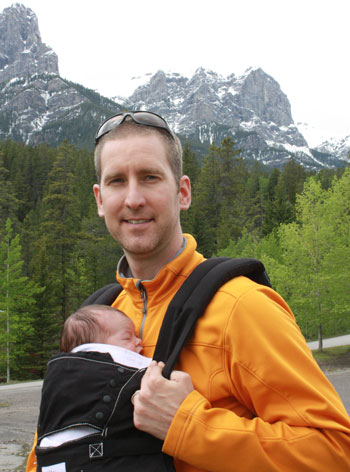
Exercise physiology professor Craig Steinback joins the faculty from the University of Calgary in January 2013. Seen here with his daughter, Emma, on a trip to the mountains.
If you're planning to climb a mountain that's higher than 2000 metres, you'll be warned about the importance of acclimatizing before ascending higher to avoid high altitude sickness - a serious ailment brought on by lower levels of oxygen in the atmosphere the higher you climb. Usually, given a few days to get used to it, the body adapts and you can continue your climb. But what happens in the body to make the adaptation possible? And how do the systems of people with lung dysfunction caused by diseases such as chronic obstructive pulmonary disease (COPD) or sleep apnea behave or adapt to hypoxia?
Dr. Craig Steinback, an exercise physiology professor who joins the faculty early 2013, is interested in how the various mechanisms in the body are regulated and interact when exposed to hypoxia (low oxygen) in both healthy and clinical populations.
"The body is designed to respond to those changes (brought on by hypoxia) through mechanisms that can be corrective or compensatory in nature," says Steinback, currently a post-doctoral fellow at the Laboratory of Human Cerebrovascular Physiology at the University of Calgary.
"If you're at altitude, for example, the corrective responses are to increase the depth and rate at which you breathe and try to draw more oxygen into the body and to redirect blood, which carries oxygen, to critical organs - the brain, heart and muscles as well.
"There are two different aspects - locally, in any given tissue a decrease in oxygen causes the blood vessels to open up to accept more blood and oxygen to those tissues. At the same time part of the nervous system will actually constrict different areas of the body to move the blood away from non-critical areas of the body to a critical area."
Steinback's primary research interest is in the sympathetic nervous system and how it is regulated, and says understanding the long term consequences of hypoxia in the body is important because clinical populations such as individuals with COPD and sleep apnea, are at risk of developing other cardiovascular consequences, hypertension (high blood pressure) or stroke.
"Even in healthy individuals who participate in activities where hypoxia is part of their sport or leisure activity, we really want to know what are the long-term consequences in these individuals and what can be done to prevent any deleterious impacts, " says Steinback.
To that end, he'll be conducting studies in the Physical Activity and Diabetes Laboratory initially until new lab space is developed, and sees plenty of opportunities to continue his collaborative research with Drs. Darren DeLorey, Michael Stickland and Michael Kennedy, as well as future collaborations with neuroscientists Drs. Dave Collins and Kelvin Jones.
"My research will use specialized techniques such as ultrasound to help us measure blood flow to different tissues and we can then look at how that blood flow is redistributed to critical tissues [during hypoxia]," he says.
"A unique part of my research is the ability to tap into that part of the [sympathetic] nervous system that controls blood flow. So we can directly record the activity in these nerves that control blood vessels and redistribute blood flow."
One of the benefits of his research is the development of new techniques looking at how the sympathetic nervous system operates. "At the basic level this research is important for other physiologists; for clinicians, this is valuable in terms of developing new treatments for pathology," says Steinback, whose current study is looking at whether oxygen therapy in sleep apnea patients can reverse some of the negative cardiovascular consequences of the condition.
In the classroom, Steinback says he's passionate about helping students understand the integrative aspects of human physiology, bringing real life examples to the classroom of studies he's done with deep sea and breath-hold divers. "You can't look at these systems in isolation," he emphasizes. "When we look at the major aspects of exercise and human physiology we commonly talk about the respiratory system and cardiovascular systems but in my research, I think the [sympathetic] nervous system is equally important and there's a lot to be learned in terms of the interactions between those three."